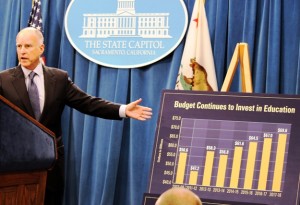Posts Tagged: schools
News
Most California public pension funds have the power to raise annual employer rates when they need more money. The California State Teachers Retirement System, a century old this year, is an outlier that needs legislation to raise rates. As lawmakers at the Capitol struggled with budget cuts during a deep economic recession, pleas for a CalSTRS rate increase were not acknowledged with a legislative hearing until last year.
News
Gov. Brown has proposed a $106.8 billion state budget for the fiscal year beginning in July that reflects an improving economy, bumps public school funding by more than $6 billion and makes no mention of a $990 million universal kindergarten program sought by legislative Democrats. (Photo: Samantha Gallegos/Capitol Weekly)
News
Following the city charter, a reluctant San Bernardino city council last week approved a police pay raise costing about $1 million, the second $1 million police salary increase since the city filed for bankruptcy last year. The four council members who voted for the 3 percent pay hike all criticized a city charter provision linking San Bernardino to the average police pay in 10 other cities, most much wealthier with higher per-capita income.
News
Buoyed by a soaring stock market and rising home prices, personal income tax receipts are flowing into the state treasury at a rate exceeding all expectations. But one big question looms as lawmakers and the governor consider how to spend the government’s new found riches: what will happen when the music stops?
News
Lowering the vote threshold for passage of local school parcel taxes would likely allow far more to pass. But there is no evidence that it would expand their use beyond the sort of wealthy Bay Area school districts that already have them. These are the key findings of a report released today by the Public Policy Institute of California (PPIC). The report assesses the potential effect of reducing the vote required to pass these taxes from two-thirds to 55 percent—a proposal the state legislature has been discussing. Although a parcel tax is one of the only local revenue options available to school districts, these taxes are not widespread. Only about 10 percent of districts have passed one, and the money raised amounts to less than 1 percent of total K–12 revenue.
News
The CalSTRS board was told last week that it’s unclear whether the new liability figure will be reported by the state or spread among school districts, where more than doubling current debt might lower credit ratings and drive up borrowing costs.
Opinion
After years of nothing but budget cuts and bad news, California’s public schools are poised for a comeback.
Our economy is improving, which has stabilized county and state revenues for the first time in nearly a decade. And in November, California voters agreed to temporarily increase taxes to support education. Though our education system
Opinion
By Elinor Benami, Jeff Deason and Julia Zuckerman
California policymakers are currently considering how to allocate Proposition 39 funds — an estimated $2.75 billion over five years. Proposition 39, as passed by voters in November, requires that half of the first five years of revenue generated from closing a business tax loophole goes toward

